Area Manager's Plan: Colesworths Performance Management System
VerifiedAdded on 2023/06/12
|6
|1202
|106
Report
AI Summary
This report outlines a plan for implementing a performance management system at Colesworths, a retail store specializing in gym and sports equipment. As the newly appointed Area Manager, the author details the consultation process for allocating work, emphasizing the importance of internal and external stakeholders. The report includes steps for creating individual objectives, managing resources efficiently, and setting performance standards related to quantity, quality, and code of conduct. Key Performance Indicators (KPIs) such as Net Promoter Score and revenue per employee are identified, along with risk assessment and mitigation strategies. The report also discusses methods for assessing employee performance through qualitative and quantitative analysis, and provides a sample key result area with SMART objectives. The importance of time management, delegation, and feedback is highlighted, along with the frequency of performance measurement across different departments. The final step involves setting up KPIs, collecting employee data, and using financial reports and surveys to make relevant reports and adjustments.
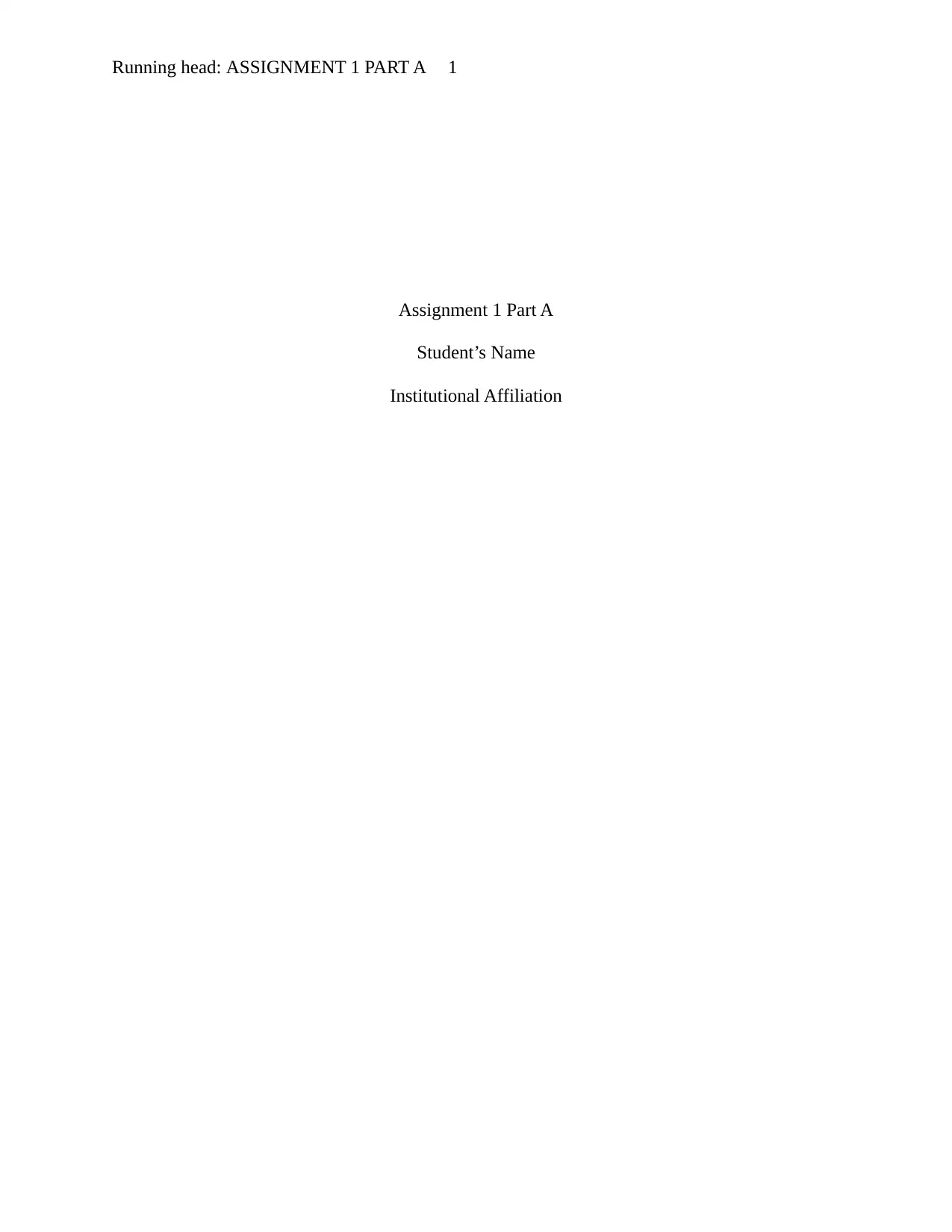
Running head: ASSIGNMENT 1 PART A 1
Assignment 1 Part A
Student’s Name
Institutional Affiliation
Assignment 1 Part A
Student’s Name
Institutional Affiliation
Paraphrase This Document
Need a fresh take? Get an instant paraphrase of this document with our AI Paraphraser
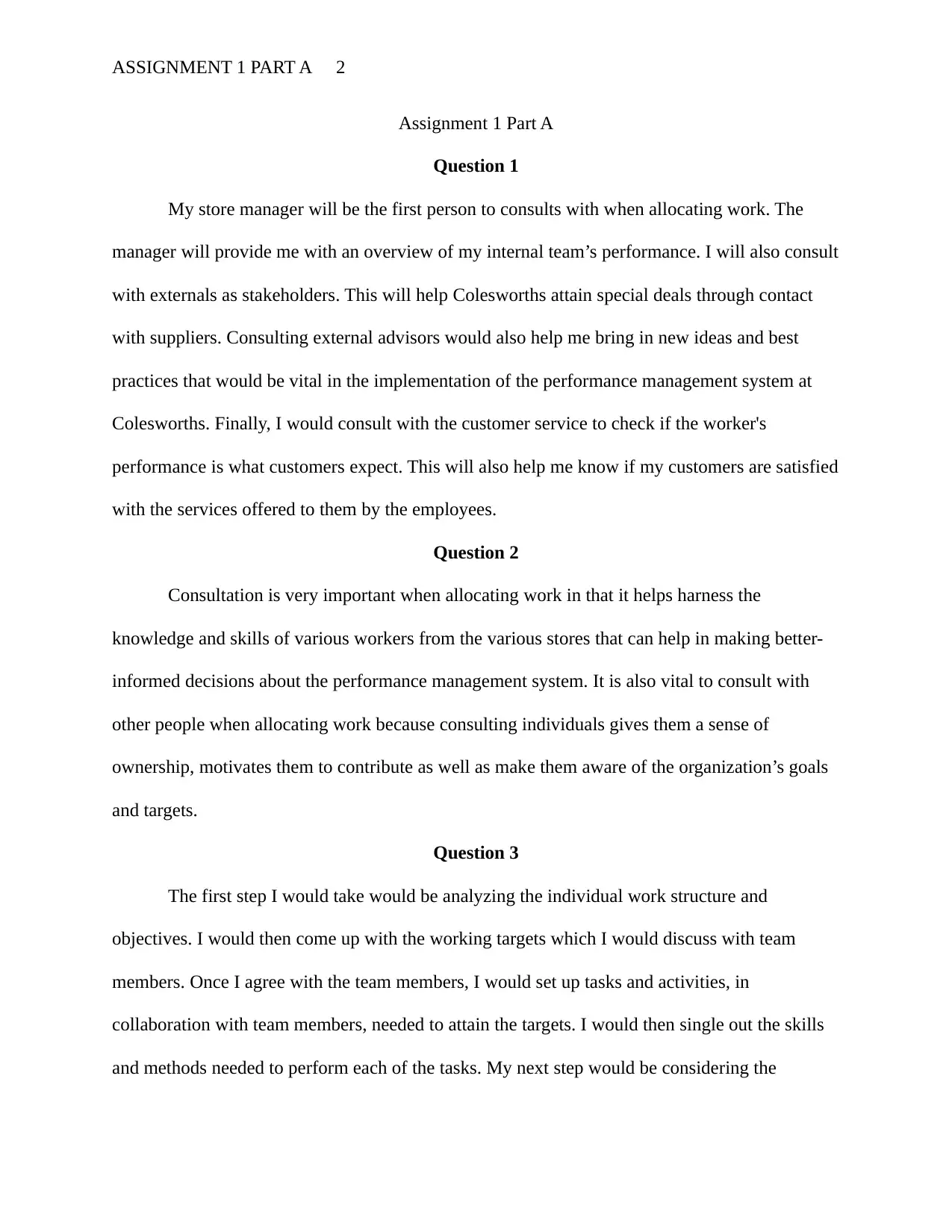
ASSIGNMENT 1 PART A 2
Assignment 1 Part A
Question 1
My store manager will be the first person to consults with when allocating work. The
manager will provide me with an overview of my internal team’s performance. I will also consult
with externals as stakeholders. This will help Colesworths attain special deals through contact
with suppliers. Consulting external advisors would also help me bring in new ideas and best
practices that would be vital in the implementation of the performance management system at
Colesworths. Finally, I would consult with the customer service to check if the worker's
performance is what customers expect. This will also help me know if my customers are satisfied
with the services offered to them by the employees.
Question 2
Consultation is very important when allocating work in that it helps harness the
knowledge and skills of various workers from the various stores that can help in making better-
informed decisions about the performance management system. It is also vital to consult with
other people when allocating work because consulting individuals gives them a sense of
ownership, motivates them to contribute as well as make them aware of the organization’s goals
and targets.
Question 3
The first step I would take would be analyzing the individual work structure and
objectives. I would then come up with the working targets which I would discuss with team
members. Once I agree with the team members, I would set up tasks and activities, in
collaboration with team members, needed to attain the targets. I would then single out the skills
and methods needed to perform each of the tasks. My next step would be considering the
Assignment 1 Part A
Question 1
My store manager will be the first person to consults with when allocating work. The
manager will provide me with an overview of my internal team’s performance. I will also consult
with externals as stakeholders. This will help Colesworths attain special deals through contact
with suppliers. Consulting external advisors would also help me bring in new ideas and best
practices that would be vital in the implementation of the performance management system at
Colesworths. Finally, I would consult with the customer service to check if the worker's
performance is what customers expect. This will also help me know if my customers are satisfied
with the services offered to them by the employees.
Question 2
Consultation is very important when allocating work in that it helps harness the
knowledge and skills of various workers from the various stores that can help in making better-
informed decisions about the performance management system. It is also vital to consult with
other people when allocating work because consulting individuals gives them a sense of
ownership, motivates them to contribute as well as make them aware of the organization’s goals
and targets.
Question 3
The first step I would take would be analyzing the individual work structure and
objectives. I would then come up with the working targets which I would discuss with team
members. Once I agree with the team members, I would set up tasks and activities, in
collaboration with team members, needed to attain the targets. I would then single out the skills
and methods needed to perform each of the tasks. My next step would be considering the
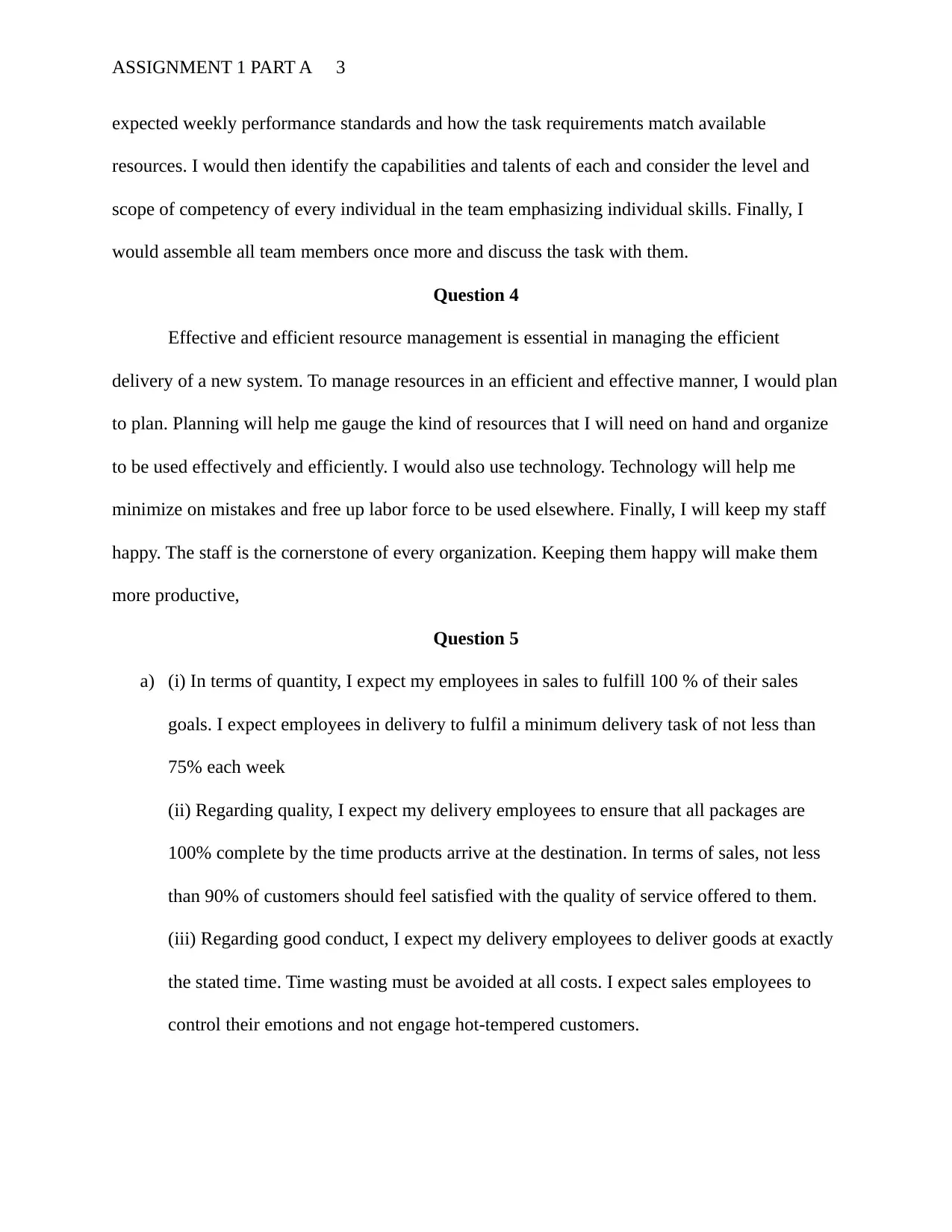
ASSIGNMENT 1 PART A 3
expected weekly performance standards and how the task requirements match available
resources. I would then identify the capabilities and talents of each and consider the level and
scope of competency of every individual in the team emphasizing individual skills. Finally, I
would assemble all team members once more and discuss the task with them.
Question 4
Effective and efficient resource management is essential in managing the efficient
delivery of a new system. To manage resources in an efficient and effective manner, I would plan
to plan. Planning will help me gauge the kind of resources that I will need on hand and organize
to be used effectively and efficiently. I would also use technology. Technology will help me
minimize on mistakes and free up labor force to be used elsewhere. Finally, I will keep my staff
happy. The staff is the cornerstone of every organization. Keeping them happy will make them
more productive,
Question 5
a) (i) In terms of quantity, I expect my employees in sales to fulfill 100 % of their sales
goals. I expect employees in delivery to fulfil a minimum delivery task of not less than
75% each week
(ii) Regarding quality, I expect my delivery employees to ensure that all packages are
100% complete by the time products arrive at the destination. In terms of sales, not less
than 90% of customers should feel satisfied with the quality of service offered to them.
(iii) Regarding good conduct, I expect my delivery employees to deliver goods at exactly
the stated time. Time wasting must be avoided at all costs. I expect sales employees to
control their emotions and not engage hot-tempered customers.
expected weekly performance standards and how the task requirements match available
resources. I would then identify the capabilities and talents of each and consider the level and
scope of competency of every individual in the team emphasizing individual skills. Finally, I
would assemble all team members once more and discuss the task with them.
Question 4
Effective and efficient resource management is essential in managing the efficient
delivery of a new system. To manage resources in an efficient and effective manner, I would plan
to plan. Planning will help me gauge the kind of resources that I will need on hand and organize
to be used effectively and efficiently. I would also use technology. Technology will help me
minimize on mistakes and free up labor force to be used elsewhere. Finally, I will keep my staff
happy. The staff is the cornerstone of every organization. Keeping them happy will make them
more productive,
Question 5
a) (i) In terms of quantity, I expect my employees in sales to fulfill 100 % of their sales
goals. I expect employees in delivery to fulfil a minimum delivery task of not less than
75% each week
(ii) Regarding quality, I expect my delivery employees to ensure that all packages are
100% complete by the time products arrive at the destination. In terms of sales, not less
than 90% of customers should feel satisfied with the quality of service offered to them.
(iii) Regarding good conduct, I expect my delivery employees to deliver goods at exactly
the stated time. Time wasting must be avoided at all costs. I expect sales employees to
control their emotions and not engage hot-tempered customers.
⊘ This is a preview!⊘
Do you want full access?
Subscribe today to unlock all pages.

Trusted by 1+ million students worldwide
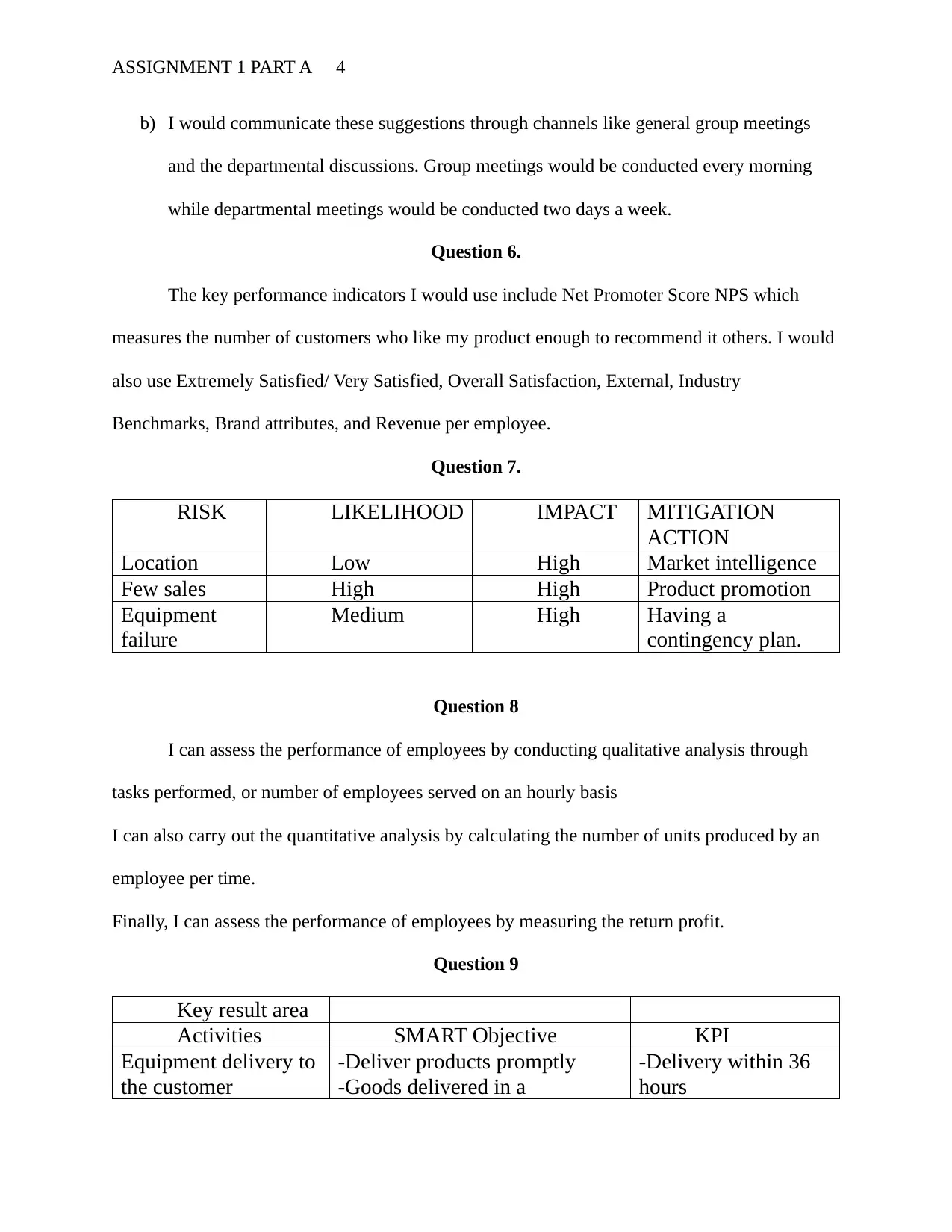
ASSIGNMENT 1 PART A 4
b) I would communicate these suggestions through channels like general group meetings
and the departmental discussions. Group meetings would be conducted every morning
while departmental meetings would be conducted two days a week.
Question 6.
The key performance indicators I would use include Net Promoter Score NPS which
measures the number of customers who like my product enough to recommend it others. I would
also use Extremely Satisfied/ Very Satisfied, Overall Satisfaction, External, Industry
Benchmarks, Brand attributes, and Revenue per employee.
Question 7.
RISK LIKELIHOOD IMPACT MITIGATION
ACTION
Location Low High Market intelligence
Few sales High High Product promotion
Equipment
failure
Medium High Having a
contingency plan.
Question 8
I can assess the performance of employees by conducting qualitative analysis through
tasks performed, or number of employees served on an hourly basis
I can also carry out the quantitative analysis by calculating the number of units produced by an
employee per time.
Finally, I can assess the performance of employees by measuring the return profit.
Question 9
Key result area
Activities SMART Objective KPI
Equipment delivery to
the customer
-Deliver products promptly
-Goods delivered in a
-Delivery within 36
hours
b) I would communicate these suggestions through channels like general group meetings
and the departmental discussions. Group meetings would be conducted every morning
while departmental meetings would be conducted two days a week.
Question 6.
The key performance indicators I would use include Net Promoter Score NPS which
measures the number of customers who like my product enough to recommend it others. I would
also use Extremely Satisfied/ Very Satisfied, Overall Satisfaction, External, Industry
Benchmarks, Brand attributes, and Revenue per employee.
Question 7.
RISK LIKELIHOOD IMPACT MITIGATION
ACTION
Location Low High Market intelligence
Few sales High High Product promotion
Equipment
failure
Medium High Having a
contingency plan.
Question 8
I can assess the performance of employees by conducting qualitative analysis through
tasks performed, or number of employees served on an hourly basis
I can also carry out the quantitative analysis by calculating the number of units produced by an
employee per time.
Finally, I can assess the performance of employees by measuring the return profit.
Question 9
Key result area
Activities SMART Objective KPI
Equipment delivery to
the customer
-Deliver products promptly
-Goods delivered in a
-Delivery within 36
hours
Paraphrase This Document
Need a fresh take? Get an instant paraphrase of this document with our AI Paraphraser
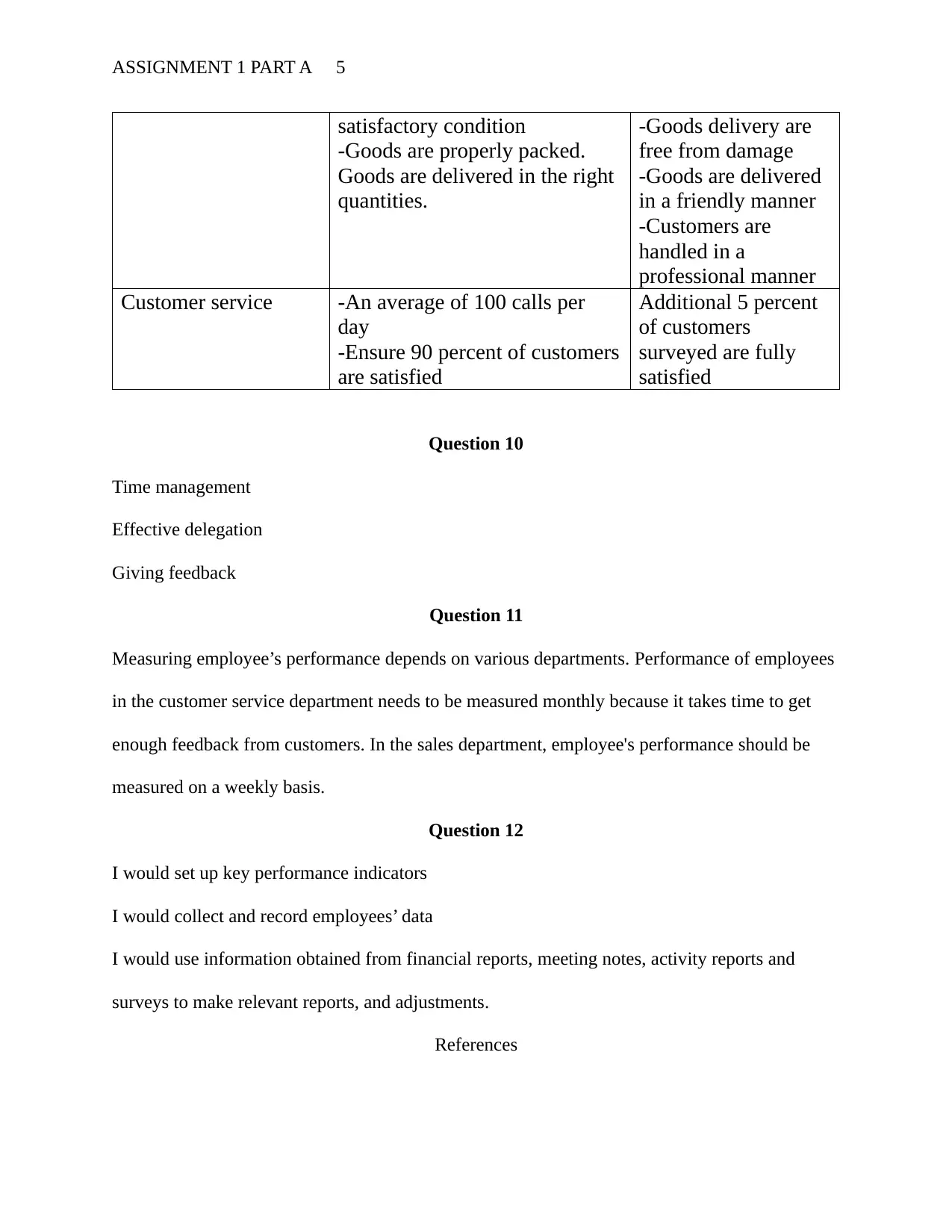
ASSIGNMENT 1 PART A 5
satisfactory condition
-Goods are properly packed.
Goods are delivered in the right
quantities.
-Goods delivery are
free from damage
-Goods are delivered
in a friendly manner
-Customers are
handled in a
professional manner
Customer service -An average of 100 calls per
day
-Ensure 90 percent of customers
are satisfied
Additional 5 percent
of customers
surveyed are fully
satisfied
Question 10
Time management
Effective delegation
Giving feedback
Question 11
Measuring employee’s performance depends on various departments. Performance of employees
in the customer service department needs to be measured monthly because it takes time to get
enough feedback from customers. In the sales department, employee's performance should be
measured on a weekly basis.
Question 12
I would set up key performance indicators
I would collect and record employees’ data
I would use information obtained from financial reports, meeting notes, activity reports and
surveys to make relevant reports, and adjustments.
References
satisfactory condition
-Goods are properly packed.
Goods are delivered in the right
quantities.
-Goods delivery are
free from damage
-Goods are delivered
in a friendly manner
-Customers are
handled in a
professional manner
Customer service -An average of 100 calls per
day
-Ensure 90 percent of customers
are satisfied
Additional 5 percent
of customers
surveyed are fully
satisfied
Question 10
Time management
Effective delegation
Giving feedback
Question 11
Measuring employee’s performance depends on various departments. Performance of employees
in the customer service department needs to be measured monthly because it takes time to get
enough feedback from customers. In the sales department, employee's performance should be
measured on a weekly basis.
Question 12
I would set up key performance indicators
I would collect and record employees’ data
I would use information obtained from financial reports, meeting notes, activity reports and
surveys to make relevant reports, and adjustments.
References
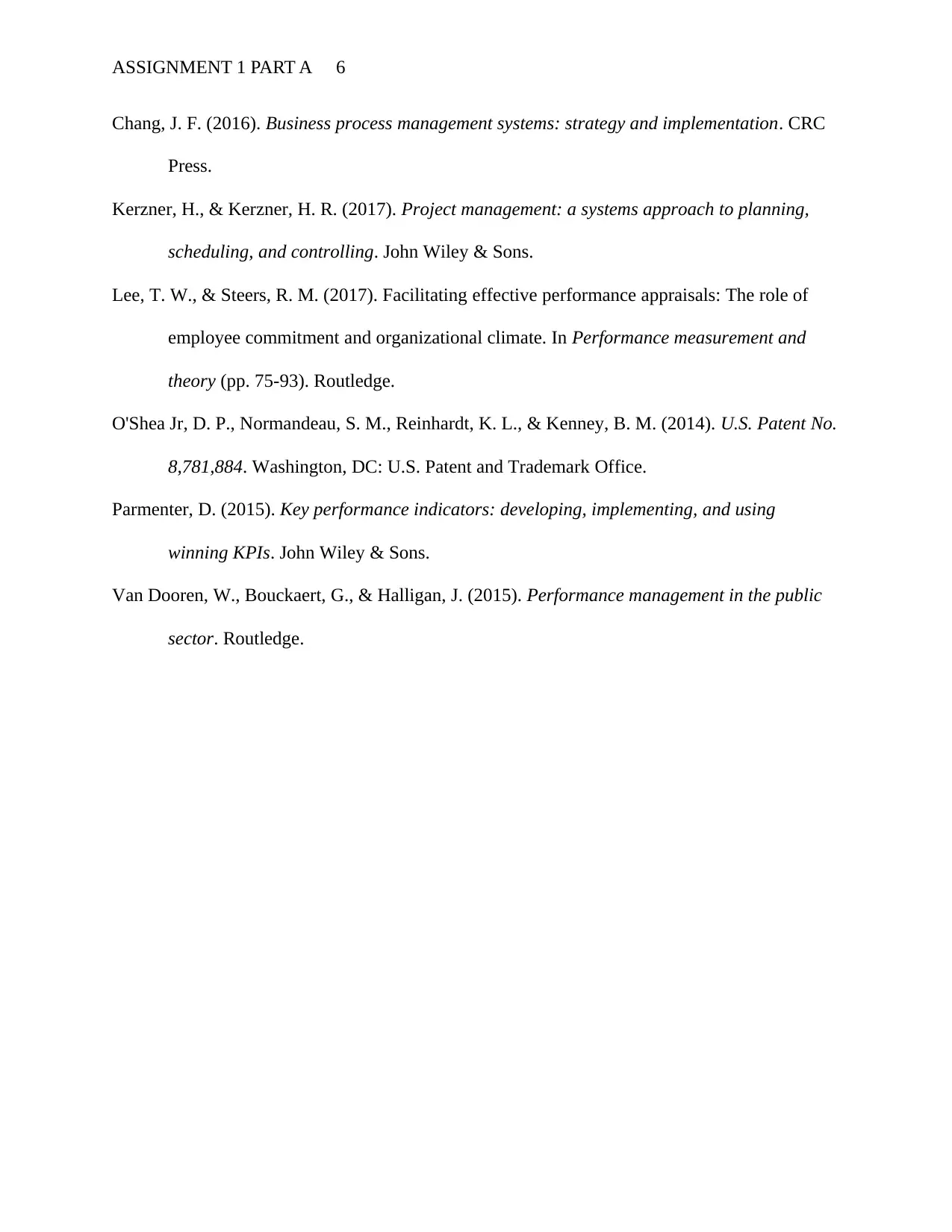
ASSIGNMENT 1 PART A 6
Chang, J. F. (2016). Business process management systems: strategy and implementation. CRC
Press.
Kerzner, H., & Kerzner, H. R. (2017). Project management: a systems approach to planning,
scheduling, and controlling. John Wiley & Sons.
Lee, T. W., & Steers, R. M. (2017). Facilitating effective performance appraisals: The role of
employee commitment and organizational climate. In Performance measurement and
theory (pp. 75-93). Routledge.
O'Shea Jr, D. P., Normandeau, S. M., Reinhardt, K. L., & Kenney, B. M. (2014). U.S. Patent No.
8,781,884. Washington, DC: U.S. Patent and Trademark Office.
Parmenter, D. (2015). Key performance indicators: developing, implementing, and using
winning KPIs. John Wiley & Sons.
Van Dooren, W., Bouckaert, G., & Halligan, J. (2015). Performance management in the public
sector. Routledge.
Chang, J. F. (2016). Business process management systems: strategy and implementation. CRC
Press.
Kerzner, H., & Kerzner, H. R. (2017). Project management: a systems approach to planning,
scheduling, and controlling. John Wiley & Sons.
Lee, T. W., & Steers, R. M. (2017). Facilitating effective performance appraisals: The role of
employee commitment and organizational climate. In Performance measurement and
theory (pp. 75-93). Routledge.
O'Shea Jr, D. P., Normandeau, S. M., Reinhardt, K. L., & Kenney, B. M. (2014). U.S. Patent No.
8,781,884. Washington, DC: U.S. Patent and Trademark Office.
Parmenter, D. (2015). Key performance indicators: developing, implementing, and using
winning KPIs. John Wiley & Sons.
Van Dooren, W., Bouckaert, G., & Halligan, J. (2015). Performance management in the public
sector. Routledge.
⊘ This is a preview!⊘
Do you want full access?
Subscribe today to unlock all pages.

Trusted by 1+ million students worldwide
1 out of 6
Related Documents
Your All-in-One AI-Powered Toolkit for Academic Success.
+13062052269
info@desklib.com
Available 24*7 on WhatsApp / Email
![[object Object]](/_next/static/media/star-bottom.7253800d.svg)
Unlock your academic potential
Copyright © 2020–2025 A2Z Services. All Rights Reserved. Developed and managed by ZUCOL.





